25th Ward
Pilsen, and the Lower West Side community area that it is part of, are the spiritual and political center of the 25th Ward. All five candidates running to replace incumbent Alderman Danny Solis, who declined to run for re-election several weeks before allegations surfaced that he wore a wire to record conversations with Alderman Ed Burke (14th), live within the Lower West Side and count Pilsen as their base. Candidates Byron Sigcho-Lopez (Pilsen Alliance), Troy Hernandez (Pilsen Environmental Rights), and Alex Acevedo (Pilsen’s Neighborhood Watch Coalition) all founded or lead organizations in the neighborhood. Hilario Dominguez worked as a community organizer with the Resurrection Project, a member organization of the Solis-affiliated Pilsen Land Use Committee, and Aida Flores taught history at Benito Juarez High School in Pilsen before serving as a CPS principal.

Most 25th Ward voters from the 2015 election lived within Pilsen or Heart of Chicago, its neighbor to the west: of 7,500 votes cast in the first round, approximately 4,700, or sixty-three percent, came from the Lower West Side. Solis won the most votes in every precinct in the ward, running against four challengers, but he only surpassed fifty percent and avoided a runoff because of strong performances in the 25th’s other neighborhoods. Parts of the West Loop and University Village, as well as low-income housing communities at Loomis Courts, Barbara Jean Wright Courts, and the Brooks Homes, are part of the 25th Ward, and they are home to over a fifth of the ward’s 2015 voters. The three precincts located within Armour Square, comprising much of Chinatown, made up just eight percent of the ward’s electorate, and the South Loop made up five percent.

Voting patterns often vary significantly across the 25th’s many neighborhoods, and became polarized in the 2015 mayoral runoff. Now-U.S. Representative Jesús “Chuy” García, who has endorsed Dominguez in this race, received better than seventy percent everywhere in the Lower West Side and McKinley Park. Mayor Rahm Emanuel won everywhere else in the ward, usually with the backing of more than two-thirds of a precinct’s voters. With all five aldermanic contenders touting their ties to Pilsen, the Lower West Side is likely to be too split to deliver anyone the clear majority García won. The campaigns that advance to a runoff will likely do it by pulling away in one of the ward’s other neighborhoods.
15th Ward
The 15th Ward takes in parts of Back of the Yards, Brighton Park, Gage Park, and West Englewood. Analysis of the results from the 2015 municipal election show that candidates looking to carry the 15th Ward will likely need to build a coalition across its several communities. A slight majority of voters in 2015 lived in the ward’s northern neighborhoods: of the 4,550 votes cast in the first-round aldermanic race from February 2015, roughly thirty-six percent (1,644 votes) came from Brighton Park, and nineteen percent (883 votes) from Back of the Yards, both predominantly Latinx neighborhoods. More than a third of voters in that election (approximately 1,600 voters, or thirty-five percent of the electorate), however, were from West Englewood, which is predominantly Black. Finally, the two precincts that are part of Gage Park held nine percent of the 2015 electorate, about 420 voters.
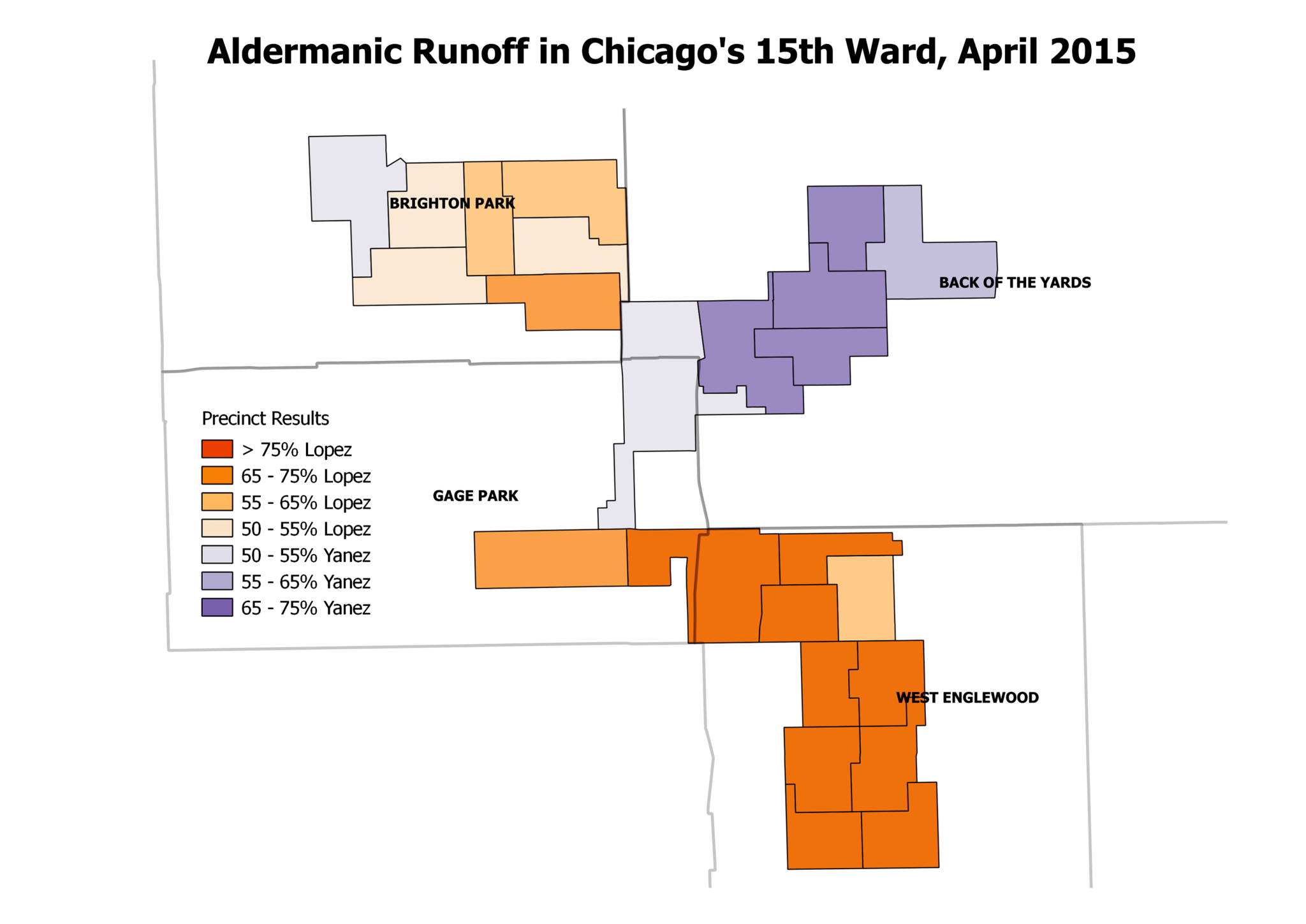
Incumbent Alderman Raymond Lopez found a winning strategy in the April 2015 runoff, receiving large margins in West Englewood and taking all but one of the precincts in Brighton Park, where he lives. Rafael Yañez fell short of Lopez in the runoff, despite winning all five precincts in his Back of the Yards neighborhood. Two other Back of the Yards residents will be on the ballot for alderman next week: Otis Davis Jr., who received ten percent of the first-round aldermanic vote in 2015, mostly from West Englewood; and first-time candidate Berto Aguayo. Another first-time candidate, Joseph Williams, will be the only candidate from West Englewood in the race. The presence of two other candidates from Back of the Yards may cut into Yañez’s numbers there, but Williams’ West Englewood residency could similarly affect the votes Lopez gets in that neighborhood. It’s possible the $95 million dollar police academy being built in West Garfield Park will be a significant factor in the race. Lopez, who supported the academy’s construction, was commended by the Sun-Times and the Tribune in their endorsements of him for his aggressive language toward gang members. Meanwhile, Yañez, a former Chicago police officer, opposes building the police academy and argues for a violence intervention model focused on economic development.
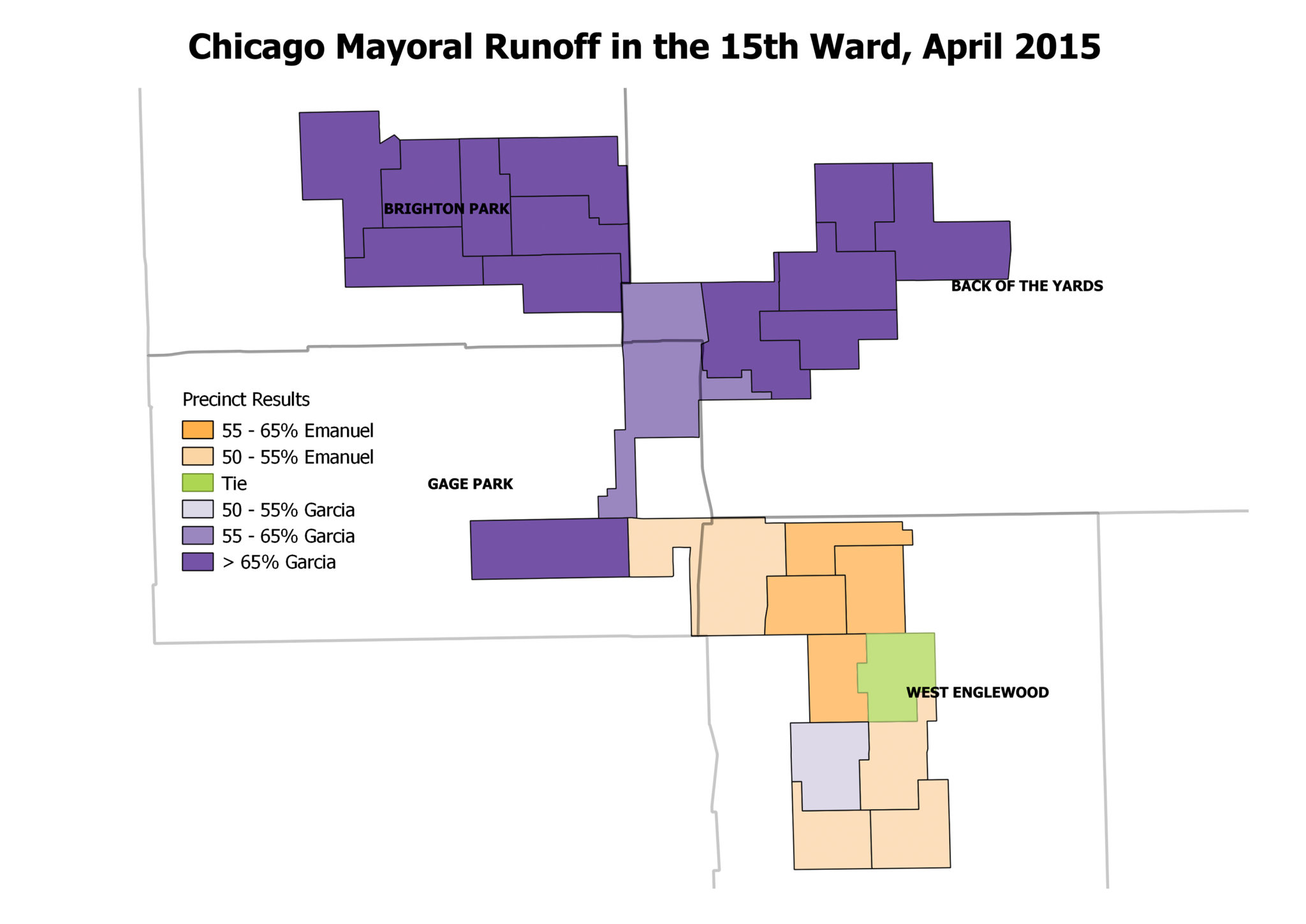
14th Ward
Asked last April if he would run for re-election to the City Council seat he has held since 1969, Alderman Edward M. Burke shot back at reporters, “Why would you wonder?” Covering parts of Garfield Ridge, Archer Heights, Brighton Park and Gage Park, Burke was confident that the ward’s voters would support him in 2019, and pointed to his brother’s success in the ward during the March 2018 Democratic primary in the 1st State Representative District. A slight majority of 14th Ward Democratic voters, 51.46%, choose then-Representative Daniel J. Burke (D-Chicago), even as his challenger, the current Representative Aaron M. Ortiz (D-Chicago), carried the southwest Chicago and suburban district with 53.12% of the overall votes.
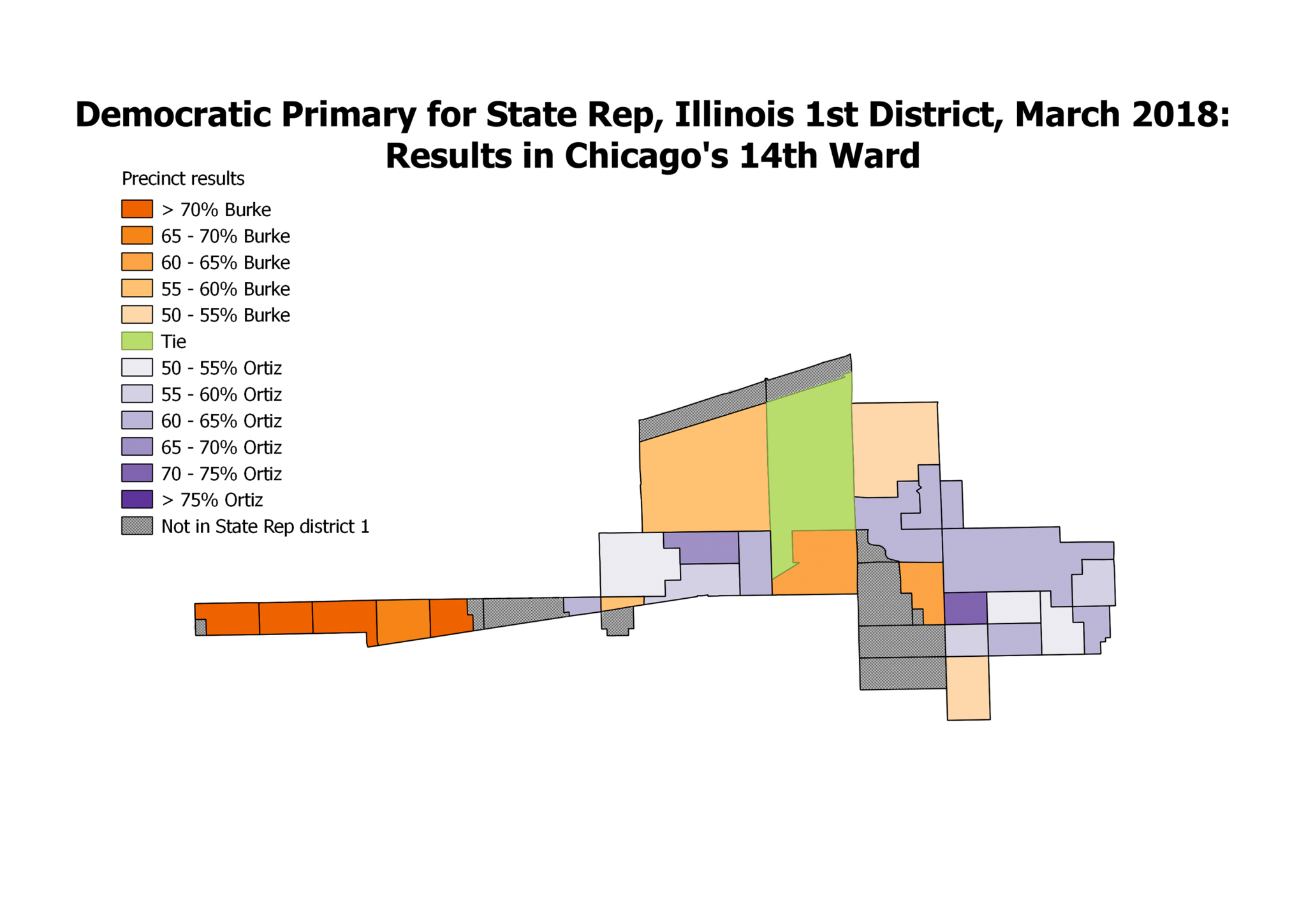
However, a closer look at the carefully gerrymandered boundaries of the 14th Ward and the 1st Representative District casts doubt on the Burke family’s ability to win a ward-wide race in 2019. By looping in a few blocks in suburban Stickney, map makers were able to include five precincts that make up the 14th Ward’s outstretched western arm, capturing parts of Garfield Ridge where the electorate is still mostly white. These five precincts were Dan Burke’s strongest base of support in the 14th Ward, and in the district as a whole, driving his 145-vote majority over Ortiz in the 14th. But the 1st state representative district excludes all of three majority-Hispanic precincts in the 14th neighborhoods of Gage Park and Brighton Park, and parts of several other similar precincts. Ed and Dan Burke’s districts were drawn early this decade to protect these incumbents from the changes that white flight and immigration would bring to their electorate, but the numbers may no longer be on their side.
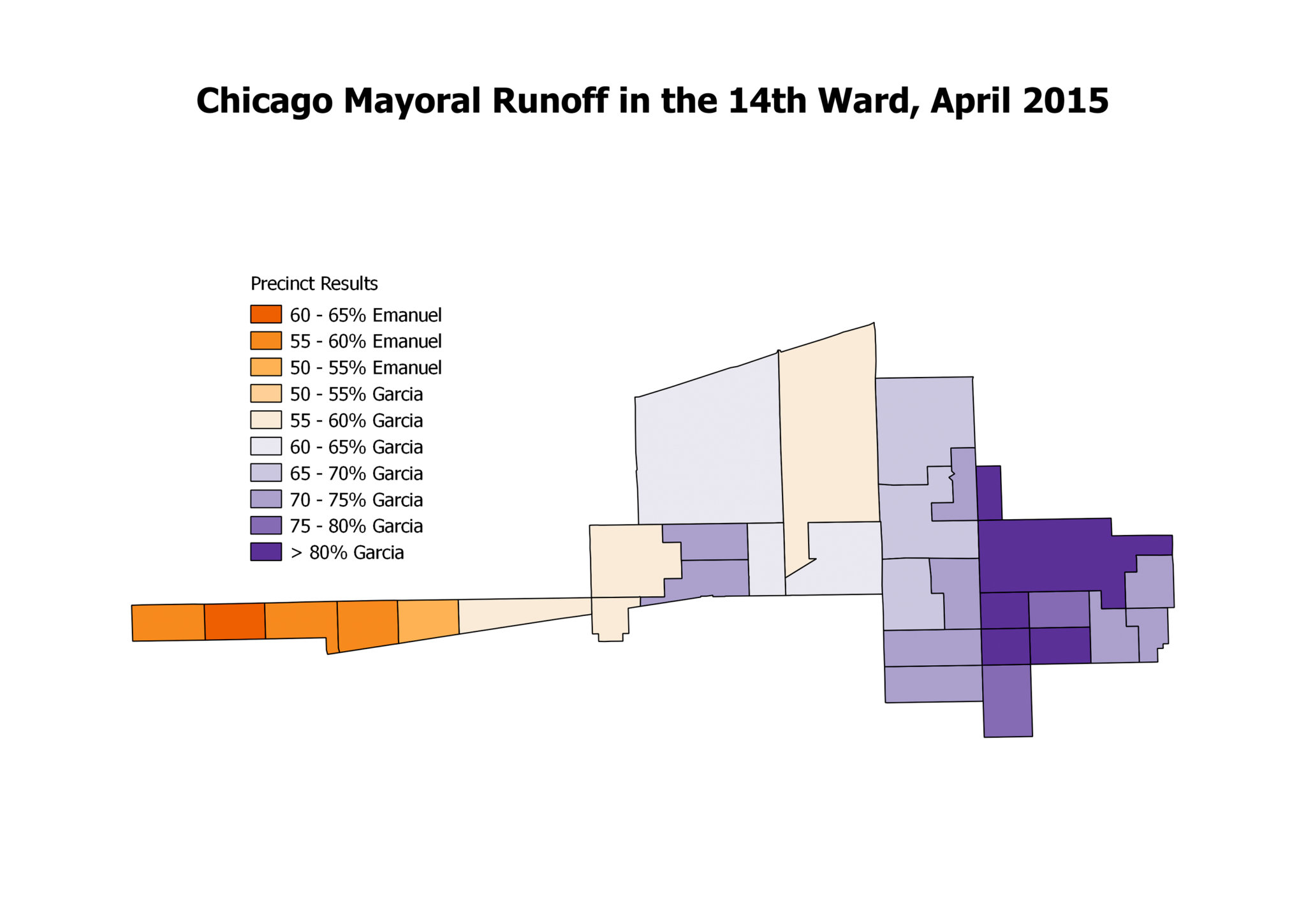
Had he taken into account how the missing 14th Ward precincts voted in the 2015 mayoral runoff, Burke might not have been so confident about his chances for re-election. Just among voters in three Gage Park precincts that are squarely within the 14th Ward, but not in the 1st district, García received 356 more votes than Rahm Emanuel, an amount greater than Dan Burke’s majority over Ortiz in the ward. Ed Burke’s challengers—Tanya Patiño, endorsed by García, and Jaime Guzmán—will be hoping these voters upset the incumbent’s calculation.
20th Ward
Nine candidates are on the ballot to be the next alderman of the 20th Ward, which stretches west from Woodlawn and includes parts of Washington Park, Greater Grand Crossing, Englewood, and Back of the Yards. Incumbent alderman Willie Cochran, a Woodlawn resident, is under indictment on corruption charges and is not running for another term.
In the first round of the 2015 aldermanic election, approximately forty-seven percent of votes cast came from Woodlawn, more than any other part of the ward. This time around, five of the nine candidates in the race live in Woodlawn, and each cites their work in the neighborhood while making their case to voters. One candidate, Jeanette Taylor, is an organizer in the campaign for a Community Benefits Agreement (CBA) for the Obama Presidential Center, reflecting concerns that development in Woodlawn will displace residents. Maya Hodari, an administrator at the Chicago Housing Authority, co-founded the Woodlawn Neighbors Association, and police officer Jennifer Maddox founded Future Ties, an afterschool program housed at Parkway Gardens, an apartment complex on Woodlawn’s western border. Quandra Speights and Denard Newell, both attorneys, are the other Woodlawn residents running.
Together, Washington Park (about 16% of February 2015 voters), Back of the Yards (eighteen percent) and Englewood (fourteen percent) just exceed Woodlawn in making up the ward’s electorate. The two contenders from Washington Park—organizer Andre Smith and Kevin Bailey, an engineer and the 20th Ward’s Democratic committeeman—both ran against Cochran in 2015, with Bailey losing in a runoff. Bailey, who knows Spanish, had his best performances in Back of the Yards, home to many Mexican-Americans, and his native Washington Park.
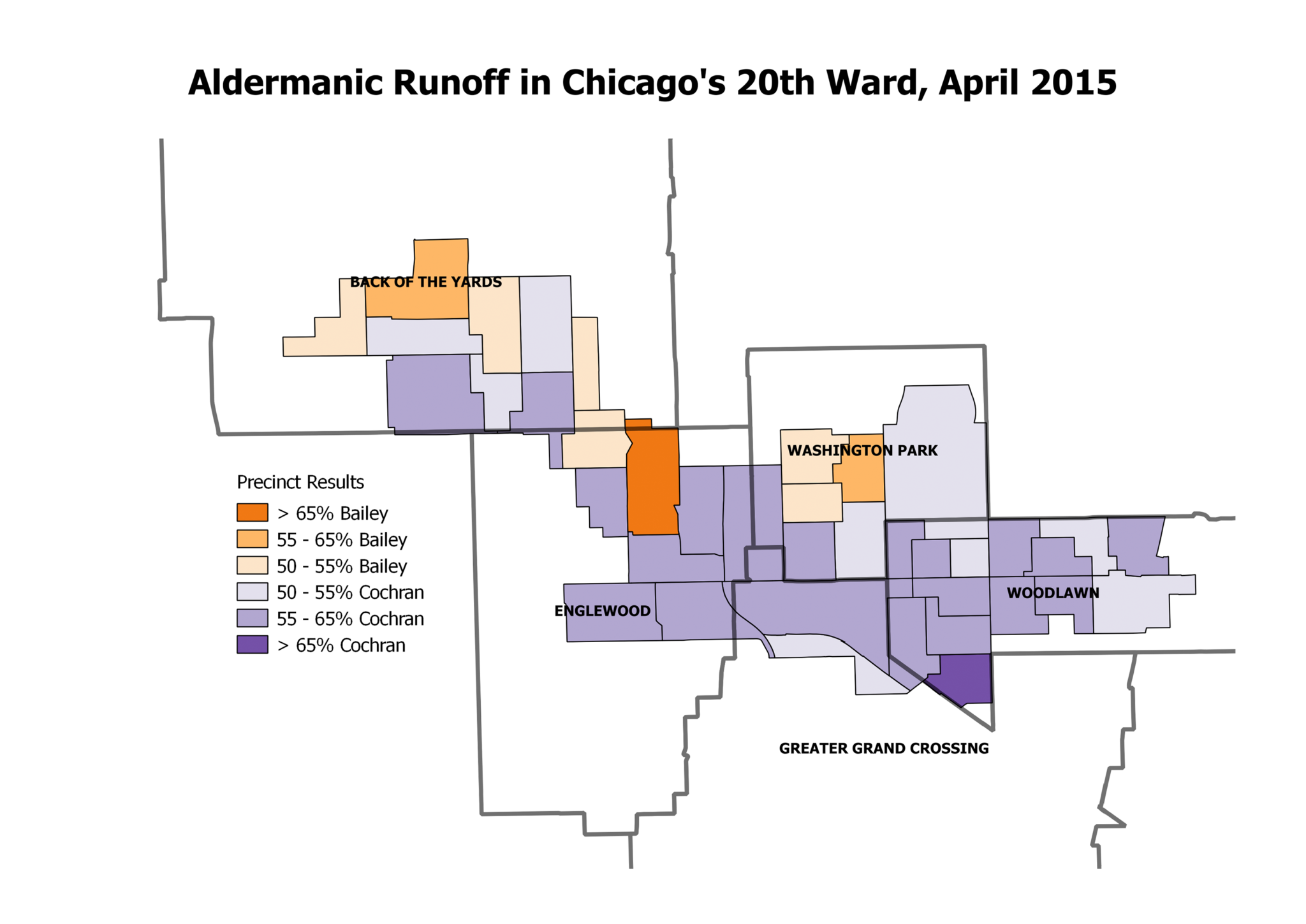
Completing the ballot, Nicole Johnson, a former teacher, and entrepreneur Anthony Driver Jr., are both in their mid-20s, and are both the only candidates from their neighborhoods. Driver says he is a fourth-generation resident of the 20th ward, and that his grandparents are pillars of the Back of the Yards community he grew up in. Johnson also lists experience as a manager with Teamwork Englewood on her résumé, and lives now in the same Englewood house she was raised in.
With so many candidates running, and most voters having at least one local option, campaigns will try to distinguish themselves from the pack across the ward. Bailey came in to the campaign with an organization in place across the ward, having run before and served as Democratic committeeman. Johnson has fundraised most successfully, most major labor unions have endorsed Taylor, and Hodari was recommended by both the Sun-Times and the Tribune. Geography and the many options before voters make the race hard to predict, but in less than a week, we will get our first indication of who the 20th ward wants to be their next alderman.
Neil Miller is a statistician and social services researcher. He is currently living in Moscow. This is his first piece for the Weekly.
